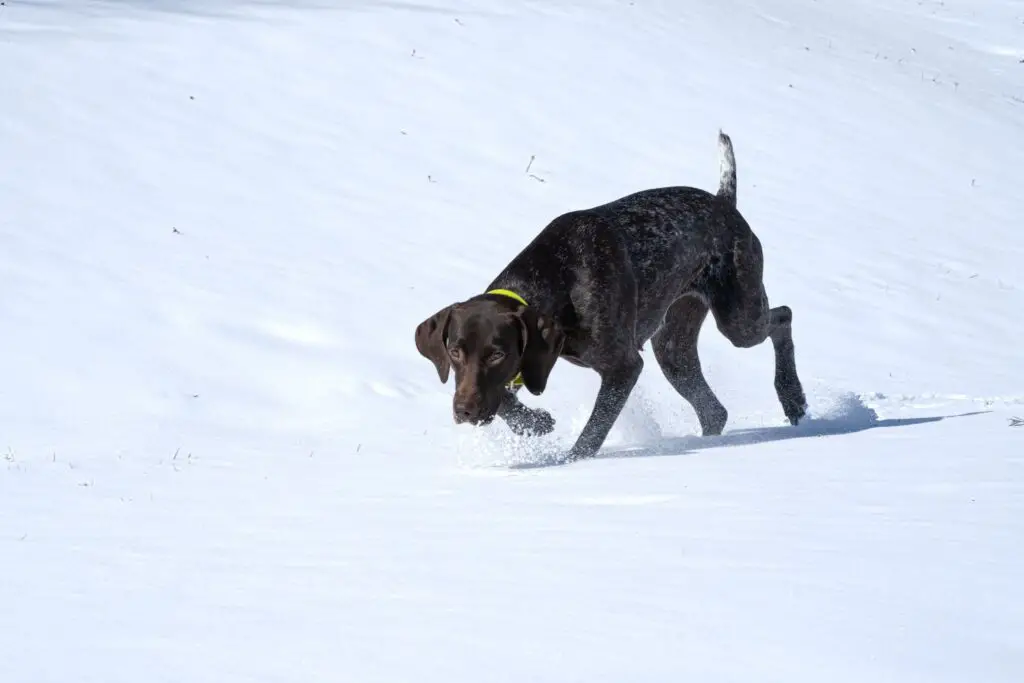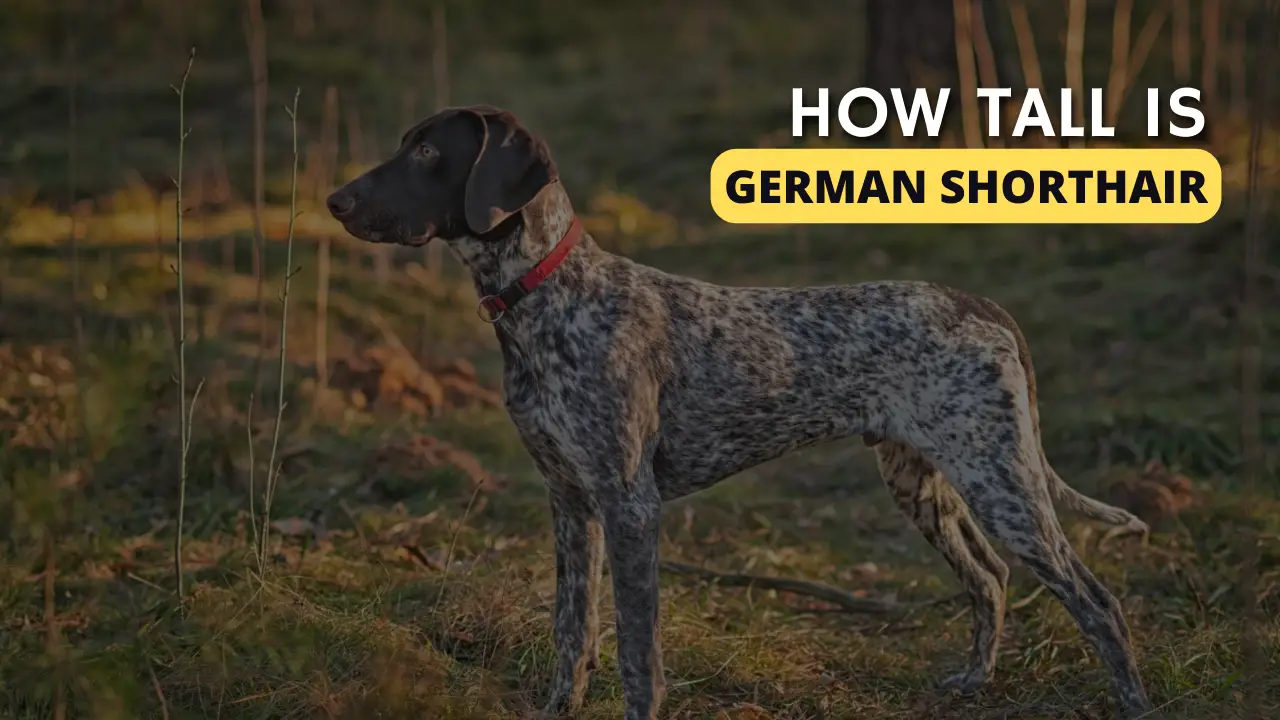If you want to add a new member to your family who would probably be the most energetic and enthusiastic, then German Shorthaired Pointer could be the appropriate choice.
These dogs are very loyal to their owners. They can be the perfect pet for those families who do not have small children because their activity level, endurance, and size can be overwhelming for the kids.
This article will tell you everything about the growth of German Shorthaired Pointers at different phases of their lives and how tall they can be after reaching adulthood. So, read this article till the end to gain a bunch of knowledge about the development of these dog breeds.
Growth Chart of a GSP
German Shorthaired Pointer is a well-known breed, often used in organized dog sports, and recognized by the American Kennel Club. To help you estimate the weight and size of your GSP, we have provided a size chart that includes average weight information.

It is important to note that not all will conform to the average weight and size data. There can be exceptions to the rule, and your dog could either be larger or smaller than what is noted in the chart. For instance, a German Shorthaired Pointer can weigh 75 pounds and still be considered healthy.
If you have concerns about your dog’s weight or size, it is always a good idea to consult a veterinarian. They will be able to provide you with personalized advice and guidance, considering your dog’s overall health and well-being.
As a large breed dog, it is important to keep them active and physically fit through regular exercise and a balanced diet. This will help maintain their overall health and well-being.
Health and Well-Being
Generally, German Shorthaired Pointers are healthy dogs well-suited for a lot of physical activity. However, like all breeds, they can be prone to certain health problems. Some of their most common health issues include elbow dysplasia and progressive retinal atrophy.
Elbow dysplasia is a genetic condition that affects the development of the elbow joint. This can cause arthritis and lameness in affected dogs. In order to reduce the risk of this condition, it is important to choose a healthy dog from a reputable breeder.
Progressive retinal atrophy is a degenerative eye disease that can lead to blindness in affected dogs. There is currently no cure for this condition, but dogs can be screened for it prior to breeding to help prevent its spread.
Overall, German Shorthaired Pointers are a breed with a solid liver that is typically healthy. Regular exercise and a balanced diet can help maintain their overall health and well-being. If you are considering adding them to your family, it is important to research and choose a reputable breeder who screens their dogs for common health problems.
Growth Chart
| Age | Male Weight | Female Weight | Male Height | Female Height |
| 2 months | 13 lbs | 10 lbs | 12 inches | 11 inches |
| 3 months | 24 lbs | 20 lbs | 15 inches | 13 inches |
| 4 months | 31 lbs | 26 lbs | 17 inches | 15 inches |
| 5 months | 37 lbs | 33 lbs | 19 inches | 17 inches |
| 6 months | 44 lbs | 40 lbs | 22 inches | 19 inches |
| 7 months | 49 lbs | 42 lbs | 23 inches | 20 inches |
| 8 months | 53 lbs | 44 lbs | 23 inches | 21 inches |
| 9 months | 55 lbs | 46 lbs | 24 inches | 21 inches |
| 10 months | 57 lbs | 49 lbs | 24 inches | 21 inches |
| 12 months | 62 lbs | 51 lbs | 24 inches | 21 inches |
| 24 months | 64 lbs | 53 lbs | 24 inches | 22 inches |
Note – Make sure you know the exact age of your dog and match it with the closest age given in the leftmost column. After that, weigh your dog and match it with the corresponding values.
At What Age Do GSPs Stop Growing?
Before getting to know the answer to this question, one has to keep in mind that dogs do not grow at the same rate. However, taking the general case, German Shorthaired Pointers are fully grown at the age of 2 years.
Their physical growth gets completed between the age of 18 to 24 months, but cognitive growth is completed at 24 months.
As an owner, you must give proper attention to your dog for better growth. For this, provide them with essential nutrients and sufficiently large areas for physical activities.
How Tall Do They Get?
As a dog owner, it is totally common to think about the height and weight they are going to achieve when they are fully grown.
However, there isn’t any clear answer to this question as growth depends on many factors. And even within the same breed, two dogs grow at different growth rates.
But there is a way to get an accurate value with the least error and this includes getting information about the parents of the dog since the genes of parents pass to their offspring, which include the hereditary factors that finally affect the dog size.
You can contact the breeder, who will give you info about your dog’s parents; by knowing the size of the parents, you can estimate your dog’s size too. But this method would not work if you’ve been to a shelter or adopted a stray dog.
Many people conduct DNA tests on their dogs to check whether they’re pure-blooded or not. If you find out they’re mixed, then the expectation of their size will also be dependent on the other dog’s breed.
GSP puppies are quite cute because the paws and head are bigger compared to the rest of the body. If this is with your dog, too, this shows they still have to complete the growth. You can also estimate your dog’s size from the growth chart provided by us.
Growth at Different Stages
Given below is information about the development of German Shorthaired Pointer puppies at different phases of their lives.

0 to 2 Weeks
In the duration of 2 weeks from their birth, like any other baby, German Shorthaired Pointers need special care. Most of the time, litter needs to be with their mother, as it would maintain their hygiene and warmth and take care of feeding them.
At this time, they would be unable to see and use their muscles to move around. They spend their day mostly feeding and sleeping.
They are very sensitive at this stage and need a suitable temperature to survive. They will easily catch a fever if the correct temperature is not provided. Let them be with their mother all the time and try not to have any contact with them.
3 to 12 Weeks
In this phase, you will see many changes in your puppies as they would start growing rapidly. The weaning process will begin, and their muscles will start getting stronger as they will walk and play like a typical puppy.
Make sure that you make the weaning process easy on them by beginning with solid foods gradually. For this, add liquid with the kibble and give them thick porridge. Generally, they get fully weaned at the age of 5 and a half weeks by getting a full set of needle-sharp teeth.
4 to 9 Months
This is the duration in which they continue their growth at a rapid rate. They explore their environment and start getting socialized with other dogs and pets. You have to give them access to a sufficiently large area for playing.
At this phase, you can start with dog training as they’ll have high energy levels. After 6 months, male German Shorthaired Pointers generally weigh 18 to 23 kg, and females weigh around 14 to 19 kg.
10 to 18 Months
By the end of this phase, you can expect a completely physically grown German Shorthaired Pointer.
After the completion of 12 months, a male and a female GSP weigh around 24 to 31 kg and 20 to 26 kg, respectively. At this phase, your dog is supposed to be in heat.
Their first heat cycle begins at the age of 6 to 12 months (8 months on average). However, giving birth at that time can be harmful. Younger dogs are not emotionally and physically ready for childbirth. Waiting for the complete development will be a better choice.
Adulthood
Even if your dog becomes physically adult, they need to complete their growth until two years of age. German Shorthaired Pointers weigh around 45 to 70 lbs at this time.
In the End
German Shorthaired Pointers are dogs with medium-sized bodies that are sometimes considered dogs from the large dog breed category. They are very energetic; hence to ensure proper growth, ensure you give them access to exercise on a daily basis and high-quality dog food.
Thanks for reading!

